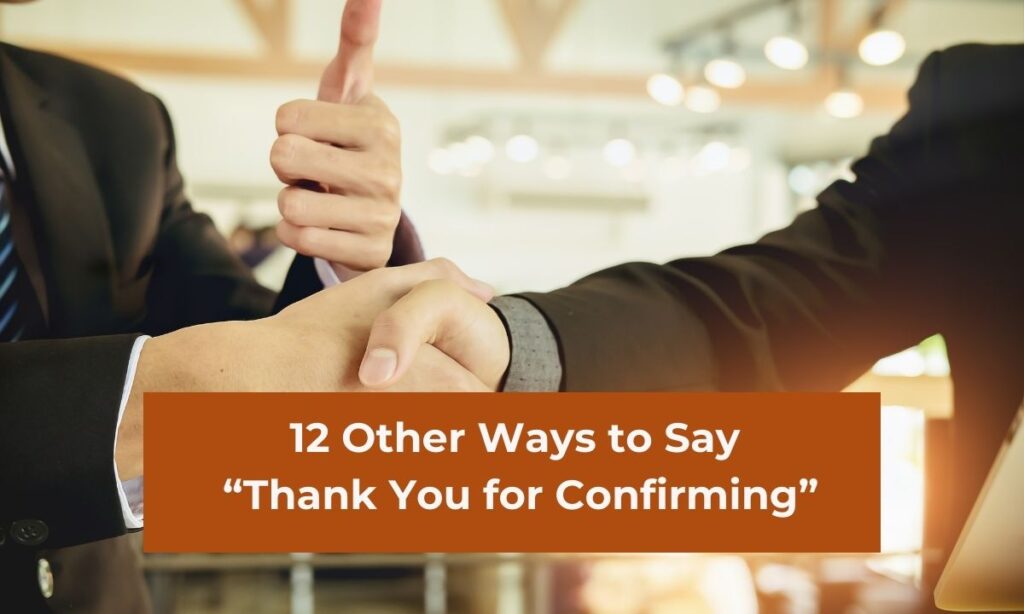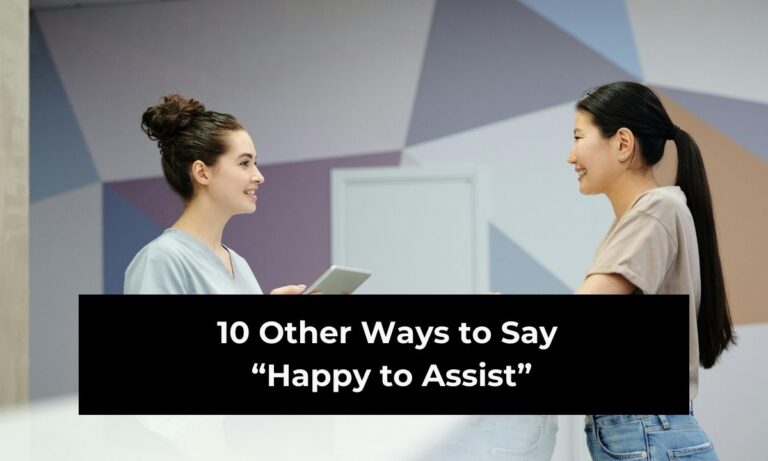Sometimes, you want to show appreciation for someone confirming details without sounding repetitive. Writing “Thank you for confirming” over and over again can feel a little stale, especially in professional communication where tone matters. You might be emailing a client, chatting with a colleague, or messaging a potential partner — in each case, finding the right wording helps you sound both polite and personable.
When you use different expressions, you keep your communication fresh and tailored to the relationship. A casual work friend might appreciate a friendly acknowledgment, while a formal client may expect something more professional. The right alternative also helps you convey the tone you want — whether it’s gratitude, relief, excitement, or readiness to move forward.
This is especially important when you work in a setting where confirmations are frequent — like project management, customer service, event planning, or sales. If you rely on the same phrase every time, it can feel robotic. Instead, a few variations can keep your responses warm, engaging, and memorable.

In this guide, you’ll find 12 creative and effective ways to say “Thank you for confirming,” along with tips for when and how to use them. Each option comes with a detailed explanation so you can pick the one that fits your situation perfectly. Whether you’re looking for something formal, casual, or slightly playful, you’ll find the right words to express your appreciation.
Must Read:
- Other Ways to Say “Thank You for the Good News”
- Other Ways to Say “Thank You for Your Generosity”
- Other Ways to Say “Thank You for Your Friendship”
1. “I Appreciate You Getting Back to Me”
This alternative is friendly, professional, and works in both formal and semi-formal contexts. It acknowledges the other person’s effort to respond and makes them feel valued.
You might use this when a colleague sends you project details or when a client confirms their availability for a meeting. It subtly highlights that you noticed they took time out of their schedule to reply.
For example:
- “I appreciate you getting back to me so quickly about the proposal.”
- “I appreciate you getting back to me with the updated numbers.”
This phrasing is great because it keeps the focus on the other person’s action, not just the confirmation itself. It also softens your tone, making it sound less transactional and more relational.
If you want to make it even warmer, you could add a short follow-up: “I appreciate you getting back to me — it helps us move forward smoothly.”
2. “Thanks for Verifying That”
This version is short, clear, and slightly more technical in tone. It works best in settings where the confirmation relates to factual information, data, or procedural steps.
It’s often used in industries like finance, law, or IT, where “verifying” has a precise meaning. For instance:
- “Thanks for verifying that your payment went through.”
- “Thanks for verifying that the file uploaded successfully.”
By using “verifying,” you emphasize accuracy and attention to detail. It tells the recipient that you value their confirmation as a part of an accurate process.
This choice also works well when you’re double-checking critical details and need to signal the importance of accuracy without sounding overly formal.
3. “I’m Grateful for Your Confirmation”
This phrasing feels more personal and heartfelt, especially when you want to express genuine appreciation. It’s well-suited for situations where the confirmation removes uncertainty or solves a problem for you.
Example uses:
- “I’m grateful for your confirmation — now we can finalize the schedule.”
- “I’m grateful for your confirmation; it really puts my mind at ease.”
This expression works beautifully in client relationships, customer service follow-ups, or even in community and volunteer settings. It sends the message that their confirmation wasn’t just expected, it was truly helpful to you.
The word “grateful” adds warmth and sincerity, making it a strong choice for when you want to strengthen rapport.
4. “Thanks for Getting That Clarified”
Sometimes confirmation comes after a bit of back-and-forth or uncertainty. In these moments, “Thanks for getting that clarified” acknowledges that they went the extra mile to make things clear.
Example:
- “Thanks for getting that clarified with the vendor.”
- “Thanks for getting that clarified — now I understand the timeline.”
This works well when there was potential for misunderstanding. It shows you value their effort in not just confirming something, but ensuring everyone’s on the same page.
It’s also great for team communication, as it reinforces that clear, confirmed information benefits the whole group.
5. “Much Appreciated”
If you’re looking for something short, casual, and to the point, “Much appreciated” is a solid choice. It’s often used in quick exchanges where you don’t need a long acknowledgment.
For example:
- “Got the delivery confirmation. Much appreciated.”
- “Noted on the schedule change. Much appreciated.”
While casual, it still carries a polite tone. It’s best suited for internal communications, messages with people you know well, or informal email sign-offs.
You can make it slightly more formal by expanding it: “That’s much appreciated” or “Your quick reply is much appreciated.”
6. “I Value Your Prompt Response”
This alternative emphasizes timeliness, making it ideal for moments when you want to recognize quick action. It works especially well when deadlines are tight.
Example:
- “I value your prompt response — it helps us keep everything on track.”
- “I value your prompt response regarding the contract changes.”
Using “value” conveys respect and professionalism. It also sends a subtle message that responding quickly is noticed and encouraged, which can help in maintaining efficiency in work relationships.
7. “Thanks for Double-Checking”
Sometimes a confirmation means someone took extra care to ensure accuracy. “Thanks for double-checking” is a great way to acknowledge that effort.
Example:
- “Thanks for double-checking those figures before we sent the report.”
- “Thanks for double-checking the venue details.”
This expression is perfect for collaborative projects where precision matters. It communicates that you value diligence and thoroughness.
It also has a friendly undertone, making it great for teamwork environments where you want to encourage careful review.
8. “Your Confirmation Helps Us Move Forward”
This phrase focuses on the positive impact of their confirmation. It’s a great way to subtly express that their action directly contributes to progress.
Example:
- “Your confirmation helps us move forward with the shipment.”
- “Your confirmation helps us move forward to the next project phase.”
By tying their action to the next step, you make them feel like a key part of the process. This is especially useful in project management, client updates, or event planning.
9. “I Appreciate the Follow-Up”
When someone confirms after a previous conversation or request, “I appreciate the follow-up” is a fitting way to respond.
Example:
- “I appreciate the follow-up on the budget details.”
- “I appreciate the follow-up — it clears up my earlier question.”
This works well when the confirmation wasn’t immediate and came after additional checking or communication. It shows you recognize the ongoing effort to keep you informed.
10. “Thanks for the Update”
Sometimes confirmation comes in the form of a small update rather than a formal statement. “Thanks for the update” is perfect for those cases.
Example:
- “Thanks for the update on the order status.”
- “Thanks for the update — that works for our schedule.”
It’s casual yet polite, making it suitable for both work and personal communications. It also works when you’re in ongoing conversations that involve multiple small confirmations.
11. “Good to Have That Settled”
This alternative has a light, conversational tone. It works when the confirmation brings closure to a discussion or decision.
Example:
- “Good to have that settled — now we can focus on the launch.”
- “Good to have that settled, thanks.”
It’s best used in friendly or team-based environments where you want to convey relief and readiness to proceed.
12. “Thanks for Making That Clear”
When a confirmation resolves confusion, “Thanks for making that clear” is a direct and appreciative way to respond.
Example:
- “Thanks for making that clear — I’ll update the documents accordingly.”
- “Thanks for making that clear; it helps avoid any mix-ups later.”
This phrase acknowledges their role in improving understanding, which can help build trust in communication.
Conclusion
Finding the right way to say “Thank you for confirming” is more than just wordplay — it’s about tailoring your message to the situation, the person you’re speaking to, and the tone you want to convey. Whether you choose something warm like “I’m grateful for your confirmation,” straightforward like “Thanks for verifying that,” or casual like “Much appreciated,” each alternative lets you express gratitude while keeping your language fresh.
By using these variations, you make your communication more engaging and personal. You show that you’re paying attention, value the other person’s time, and understand the importance of making every exchange count. Over time, these small shifts in wording can help you strengthen professional relationships and make your messages stand out.
FAQs
1. Why should I avoid repeating “Thank you for confirming” too often?
Repetition can make your messages sound mechanical. Using alternatives keeps communication fresh and engaging.
2. Are these alternatives suitable for professional emails?
Yes, many of these phrases are professional and can be tailored for formal or casual work settings.
3. Can I use these alternatives in text messages?
Absolutely. Shorter options like “Much appreciated” or “Thanks for the update” work well in texts.
4. Which alternative is best for urgent responses?
“I value your prompt response” or “Thanks for getting back to me so quickly” highlight urgency well.
5. Should I always personalize the follow-up after confirmation?
Whenever possible, yes. Adding context shows genuine appreciation and strengthens connections.





